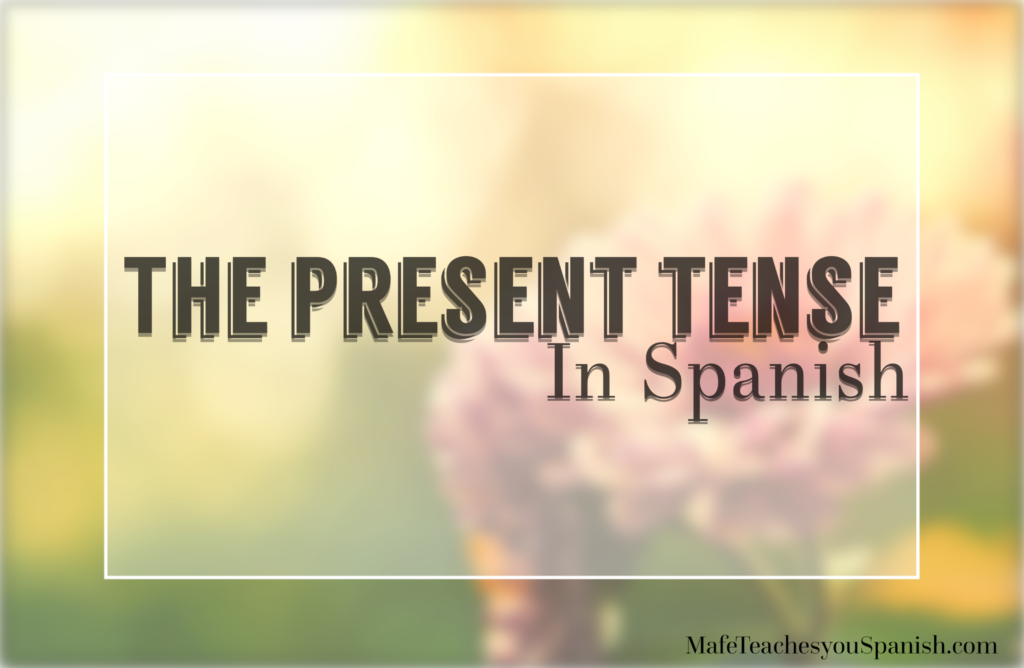
We use the present tense to describe things that happen now, for example:
- I eat an Apple
- You watch a movie
- She walks fast
- We visit our friends
Etc..
And for things that happen all the time, for example:
- I go to school every day
- You eat breakfast every morning
- He calls me all the time
- We always eat there
Etc…
Conjugation of Verbs in Spanish in the Present Tense
In Spanish we have 3 groups of verbs:
Verbs that end in –AR, -ER, -IR, and each group has its own conjugations. You just need to drop the ending of the verb in the infinitive form, and use the root of the verb to create the conjugations: the root of the verb + corresponding ending
-AR Verbs
Hablar, trabajar, bailar, cantar, estudiar, caminar
1. We drop the AR and use just the root of the verb:
Hablar (to talk) > Habl_
2. Add the corresponding ending for each pronoun:
Yo hablO – (I talk )
Tú hablAS – (You talk, informal)
Usted hablA – (You talk, formal )
Él hablA – (He talks)
Ella hablA- (She talks)
Nosotros hablAMOS- (We talk)
Ustedes hablAN- (You talk – Plural)
Ellos hablAN – (They talk – masculine)
Ellas hablAN – (They talk – feminine)
As you can see, the conjugations for él, ella, usted are the same (habla). And the conjugations for ustedes, ellos, ellas are the same (hablan). This happens all the time in Spanish!
-ER Verbs
Comer, beber, leer, correr, aprender
1. We drop the ER and use just the root of the verb:
Comer (to eat) > Com_
2. Add the corresponding ending for each pronoun:
Yo comO – (I eat)
Tú comES – (You eat, informal)
Usted comE – (You eat, formal)
Él comE – (He eats)
Ella comE – (She eats)
Nosotros comEMOS – (We eat)
Ustedes comEN – (You eat, plural)
Ellos comEN – (They eat, masculine)
Ellas comEN – (They eat, feminine)
-IR Verbs
Vivir, abrir, escribir
1. We drop the IR and use just the root of the verb:
Vivir (to live) > Viv_
2. Add the corresponding ending for each pronoun:
Yo vivO – (I live)
Tú vivES – (You live, informal)
Usted vivE – (You live, formal)
Él vivE – (He lives)
Ella vivE – (She lives)
Nosotros vivIMOS – (We live)
Ustedes vivEN – (You live, plural)
Ellos vivEN – (They live, masculine)
Ellas vivEN – (They live, feminine)
As you can see, the ER and IR verbs, have almost the same conjugations, except for -nosotros-.
SUMMARY

EXAMPLES PRESENT TENSE IN SPANISH
- Yo veo una película (I watch a movie)
- María escucha la radio (María listens to the radio)
- Mis amigos caminan a la escuela (My friends walk to school)
- Tú hablas español (You speak Spanish)
- Nosotros trabajamos en esa compañia (We work in that company)
- Ellos leen un libro de historia (They read a history book)
- Él habla con su padre (He talks to his father)
- Ustedes escriben las cartas (You guys write the letters)
- Ella siempre compra mucha ropa (They always buy a lot of clothes)
- Usted nunca corre en el parque (You never run in the park)
- Los niños nadan en la piscina (The kids swim in the pool)
- La secretaria limpia su escritorio (The secretary cleans her desk)
Take a lesson about the PRESENT TENSE IN SPANISH
Having trouble understanding the use of this tense? Would you like to practice it in real life?
Send me a message to book a lesson now and I will help you to understand, practice and use this tense and more.
PRACTICE THE PRESENT TENSE IN SPANISH:
Yo…. con mi padre todas las noches (hablar)
Tú….. siempre mucho chocolate (comer)
Andrea ….. la ventana (abrir)
Ellos …… jugo de naranja (beber)
Nosotros no …… canciones de amor (cantar)
Ella ….. con su novio (bailar)
Nosotros ….. a cocinar (aprender)
Ustedes….. en un edificio (trabajar)
Ellos ….. cuentos para niños (leer)